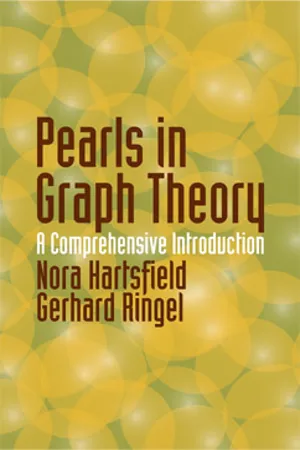
eBook - ePub
Pearls in Graph Theory
A Comprehensive Introduction
- 272 pages
- English
- ePUB (mobile friendly)
- Available on iOS & Android
eBook - ePub
About this book
"Innovative introductory text . . . clear exposition of unusual and more advanced topics . . . Develops material to substantial level." — American Mathematical Monthly
"Refreshingly different . . . an ideal training ground for the mathematical process of investigation, generalization, and conjecture leading to the discovery of proofs and counterexamples." — American Mathematical Monthly
" . . . An excellent textbook for an undergraduate course." — Australian Computer Journal
A stimulating view of mathematics that appeals to students as well as teachers, this undergraduate-level text is written in an informal style that does not sacrifice depth or challenge. Based on 20 years of teaching by the leading researcher in graph theory, it offers a solid foundation on the subject. This revised and augmented edition features new exercises, simplifications, and other improvements suggested by classroom users and reviewers. Topics include basic graph theory, colorings of graphs, circuits and cycles, labeling graphs, drawings of graphs, measurements of closeness to planarity, graphs on surfaces, and applications and algorithms. 1994 edition.
"Refreshingly different . . . an ideal training ground for the mathematical process of investigation, generalization, and conjecture leading to the discovery of proofs and counterexamples." — American Mathematical Monthly
" . . . An excellent textbook for an undergraduate course." — Australian Computer Journal
A stimulating view of mathematics that appeals to students as well as teachers, this undergraduate-level text is written in an informal style that does not sacrifice depth or challenge. Based on 20 years of teaching by the leading researcher in graph theory, it offers a solid foundation on the subject. This revised and augmented edition features new exercises, simplifications, and other improvements suggested by classroom users and reviewers. Topics include basic graph theory, colorings of graphs, circuits and cycles, labeling graphs, drawings of graphs, measurements of closeness to planarity, graphs on surfaces, and applications and algorithms. 1994 edition.
Frequently asked questions
Yes, you can cancel anytime from the Subscription tab in your account settings on the Perlego website. Your subscription will stay active until the end of your current billing period. Learn how to cancel your subscription.
No, books cannot be downloaded as external files, such as PDFs, for use outside of Perlego. However, you can download books within the Perlego app for offline reading on mobile or tablet. Learn more here.
Perlego offers two plans: Essential and Complete
- Essential is ideal for learners and professionals who enjoy exploring a wide range of subjects. Access the Essential Library with 800,000+ trusted titles and best-sellers across business, personal growth, and the humanities. Includes unlimited reading time and Standard Read Aloud voice.
- Complete: Perfect for advanced learners and researchers needing full, unrestricted access. Unlock 1.4M+ books across hundreds of subjects, including academic and specialized titles. The Complete Plan also includes advanced features like Premium Read Aloud and Research Assistant.
We are an online textbook subscription service, where you can get access to an entire online library for less than the price of a single book per month. With over 1 million books across 1000+ topics, we’ve got you covered! Learn more here.
Look out for the read-aloud symbol on your next book to see if you can listen to it. The read-aloud tool reads text aloud for you, highlighting the text as it is being read. You can pause it, speed it up and slow it down. Learn more here.
Yes! You can use the Perlego app on both iOS or Android devices to read anytime, anywhere — even offline. Perfect for commutes or when you’re on the go.
Please note we cannot support devices running on iOS 13 and Android 7 or earlier. Learn more about using the app.
Please note we cannot support devices running on iOS 13 and Android 7 or earlier. Learn more about using the app.
Yes, you can access Pearls in Graph Theory by Nora Hartsfield,Gerhard Ringel, Gerhard Ringel in PDF and/or ePUB format, as well as other popular books in Mathematics & Mathematics General. We have over one million books available in our catalogue for you to explore.
Information
Chapter 1

BASIC GRAPH THEORY
1.1 Graphs and Degrees of Vertices
Before we give any definitions and theory, let us consider the following example. There is a basket containing an apple, a banana, a cherry and a date. Four children named Erica, Frank, Greg and Hank are each to be given a piece of the fruit. Erica likes cherries and dates; Frank likes apples and cherries; Greg likes bananas and cherries; and Hank likes apples, bananas, and dates. Figure 1.1.1 describes the situation. The problem is to give each child a piece of fruit that he or she likes. The reader is invited to find a solution. One can see the advantage of using Figure 1.1.1 as an aid to solving the problem.
Figure 1.1.1 is, in fact, an example of a graph. Another example with which we are all familiar is a road map. The map in Figure 1.1.2 is greatly simplified, of course. It shows some different ways of driving from San Jose to San Francisco.

Figure 1.1.1

Figure 1.1.2
Chemists use diagrams to picture molecules, and these diagrams are also graphs. Usually the hydrogen atoms are omitted from the diagrams by the chemists using shorthand structure, but the Kekulé structure includes them.

Figure 1.1.3. Water, H2O.

Figure 1.1.4. Butane and isobutane, C4H10.
In Figures 1.1.6 and 1.1.7 the labels for carbon, hydrogen, and oxygen have been left out. See Figure 1.3.6 for another molecule C60.
Graph theory is used in designing printed circuits for use in electronics devices. Circuits printed on silicon chips must be designed differently from those using insulated wires, since the conducting portions cannot cross one another. The graph of Figure 1.1.8 shows part of a printed circuit used in a computer.
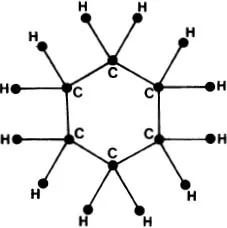
Figure 1.1.5. Cyclohexane, C6H12.

Figure 1.1.6. Aspirin, C9H8O4.
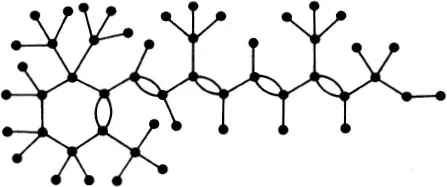
Figure 1.1.7. Vitamin A, C20H30O.
Algorithms can also be described by graphs. The graph of Figure 1.1.9 is a chart of the steps used in an algorithm for solving a certain problem using a computer.

Figure 1.1.8. Portion of a printed circuit

Figure 1.1.9
In the study of lattices and Boolean algebras, graphs arise as diagrams of these structures. Those who have studied set theory will recognize the diagrams of Figures 1.1.10 and 1.1.11 as lattices of subsets. For convenience, we use shorter notation for sets; for example, we write ABD for the set {A, B, D}. The diagrams of Figures 1.1.10 and 1.1.11 show all subsets of the set at the top. If one set is derived from another by deleting one element, then the two sets are connected by a line in the diagram.
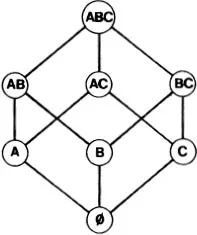
Figure 1.1.10. The lattice of subsets of ABC.
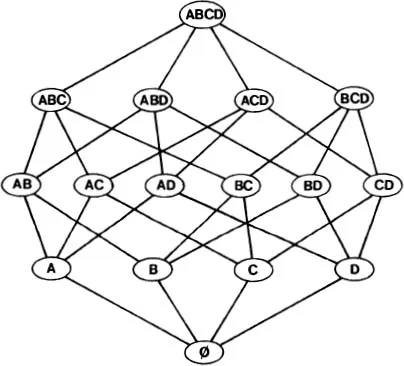
Figure 1.1.11
The different factorizations of the integer 60 are shown in the diagram of Figure 1.1.12. Some more examples of graphs are shown in Figures 1.1.13, 1.1.14, 1.1.15, 1.1.16, and 1.1.17.
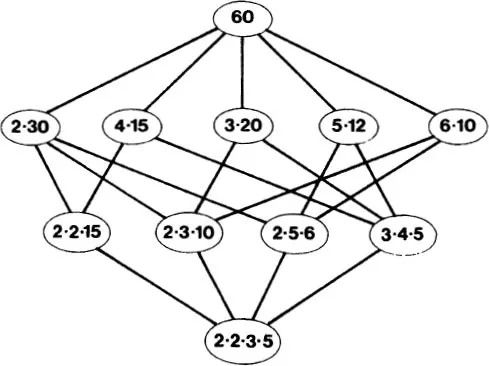
Figure 1.1....
Table of contents
- Cover
- Title Page
- Copyright Page
- Contents
- Foreword to the Revised Edition
- Foreword
- Chapter 1. Basic Graph Theory
- Chapter 2. Colorings of Graphs
- Chapter 3. Circuits and Cycles
- Chapter 4. Extremal Problems
- Chapter 5. Counting
- Chapter 6. Labeling Graphs
- Chapter 7. Applications and Algorithms
- Chapter 8. Drawings of Graphs
- Chapter 9. Measurements of Closeness to Planarity
- Chapter 10. Graphs on Surfaces
- References
- Index